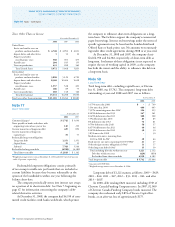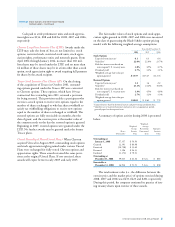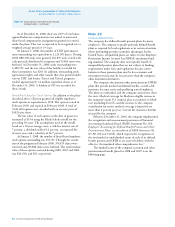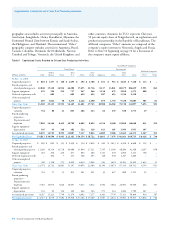Chevron 2008 Annual Report Download - page 88
Download and view the complete annual report
Please find page 88 of the 2008 Chevron annual report below. You can navigate through the pages in the report by either clicking on the pages listed below, or by using the keyword search tool below to find specific information within the annual report.
86 Chevron Corporation 2008 Annual Report
The pension plans invest primarily in asset categories with
sufficient size, liquidity and cost efficiency to permit invest-
ments of reasonable size. The pension plans invest in asset
categories that provide diversification benefits and are easily
measured. To assess the plans’ investment performance, long-
term asset allocation policy benchmarks have been established.
For the primary U.S. pension plan, the Chevron Board
of Directors has approved the following percentage asset-allo-
cation ranges: equities 40–70, fixed income/cash 20–60, real
estate 0–15 and other 0–5. The significant international pen-
sion plans also have established maximum and minimum asset
allocation ranges that vary by each plan. Actual asset alloca-
tion, within approved ranges, is based on a variety of current
economic and market conditions and consideration of specific
asset category risk.
Equities include investments in the company’s common
stock in the amount of $22 and $36 at December 31, 2008
and 2007, respectively. The “Other” asset category includes
minimal investments in private-equity limited partnerships.
Cash Contributions and Benefit Payments In 2008, the com-
pany contributed $577 and $262 to its U.S. and international
pension plans, respectively. In 2009, the company expects
contributions to be approximately $550 and $250 to its U.S.
and international pension plans, respectively. Actual contri-
bution amounts are dependent upon plan-investment returns,
changes in pension obligations, regulatory environments and
other economic factors. Additional funding may ultimately
be required if investment returns are insufficient to offset
increases in plan obligations.
The company anticipates paying other postretirement
benefits of approximately $209 in 2009, as compared with
$188 paid in 2008.
The following benefit payments, which include estimated
future service, are expected to be paid in the next 10 years:
Pension Benefits Other
U.S. Int’l. Benefits
2009 $ 853 $ 226 $ 209
2010 $ 841 $ 249 $ 216
2011 $ 849 $ 240 $ 222
2012 $ 863 $ 265 $ 225
2013 $ 874 $ 277 $ 230
2014–2018 $ 4,379 $ 1,746 $ 1,205
Employee Savings Investment Plan Eligible employees of
Chevron and certain of its subsidiaries participate in the
Chevron Employee Savings Investment Plan (ESIP).
Charges to expense for the ESIP represent the company’s
contributions to the plan, which are funded either through
the purchase of shares of common stock on the open market
or through the release of common stock held in the leveraged
employee stock ownership plan (LESOP), which follows.
Total company matching contributions to employee accounts
within the ESIP were $231, $206 and $169 in 2008, 2007
and 2006, respectively. This cost was reduced by the value of
shares released from the LESOP totaling $40, $33 and $6 in
2008, 2007 and 2006, respectively. The remaining amounts,
totaling $191, $173 and $163 in 2008, 2007 and 2006,
respectively, represent open market purchases.
Employee Stock Ownership Plan Within the Chevron ESIP
is an employee stock ownership plan (ESOP). In 1989,
Chevron established a LESOP as a constituent part of the
ESOP. The LESOP provides partial prefunding of the com-
pany’s future commitments to the ESIP.
As permitted by American Institute of Certified Public
Accountants (AICPA) Statement of Position 93-6, Employers’
Accounting for Employee Stock Ownership Plans, the company
has elected to continue its practices, which are based on
AICPA Statement of Position 76-3, Accounting Practices for
Certain Employee Stock Ownership Plans, and subsequent con-
sensus of the EITF of the FASB. The debt of the LESOP is
recorded as debt, and shares pledged as collateral are reported
as “Deferred compensation and benefit plan trust” on the
Consolidated Balance Sheet and the Consolidated Statement
of Stockholders’ Equity.
The company reports compensation expense equal to
LESOP debt principal repayments less dividends received
and used by the LESOP for debt service. Interest accrued
on LESOP debt is recorded as interest expense. Dividends
paid on LESOP shares are reflected as a reduction of retained
earnings. All LESOP shares are considered outstanding for
earnings-per-share computations.
A net credit to expense of $1 was recorded for the
LESOP each year in 2008, 2007 and 2006. The net credit
for the respective years was composed of credits to compen-
sation expense of $15, $17 and $18 and charges to interest
expense for LESOP debt of $14, $16 and $17.
Of the dividends paid on the LESOP shares, $35, $8
and $59 were used in 2008, 2007 and 2006, respectively,
to service LESOP debt. The amount in 2006 included $28
of LESOP debt service that was scheduled for payment on
the first business day of January 2007 and was paid in late
December 2006. No contributions were required in 2008,
2007 or 2006 as dividends received by the LESOP were
sufficient to satisfy LESOP debt service.
Note 22 Employee Benefit Plans – Continued
Notes to the Consolidated Financial Statements
Millions of dollars, except per-share amounts
























